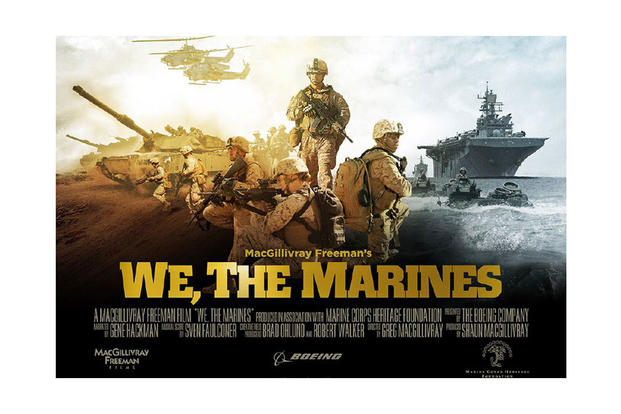The biggest challenge in filming a documentary about Marines for the giant screen wasn't getting the breathless aerial shots of troops jumping from the back of aircraft or rappelling from mountainsides.
It was learning to work with leathernecks and their capricious and unpredictable training schedules, said Brad Ohlund, director of photography for the film.
Last week, the National Museum of the Marine Corps in Quantico, Virginia, christened its new giant-screen Medal of Honor Theater with the debut of "We, the Marines," a 40-minute journey from boot camp to the Corps' most rigorous and dynamic training locations across the country.
Shot almost entirely digitally, the film is visually sumptuous and constantly entertaining, with wide vistas and up-close views of the dirt, sweat, tears and snot that go into the making of a Marine.
The film was the result of years of work and proved a daunting task, Ohlund told Military.com at its premiere Saturday.
"The most challenging thing in making this movie was the Marine Corps. And every Marine will understand that," he said. "Because the Marine Corps says, 'We're going to do this, then,' and they end up doing that, a little later. So we had a rule of thumb: When we go out to shoot, we're gonna get 30 percent of what they tell us we're going to get."
Ultimately, the crew ended up with 180 hours of footage, two or three times what is typical for a project of the size.
"Making this film was next to impossible," director Greg MacGillivray, a veteran filmmaker and director of the iconic "To Fly" documentary at the Smithsonian's Air and Space Museum, told an audience of Marine brass at the film's first showing.
"We had to do more with less, just like the Marine Corps. We had to go and do it as it happened; we couldn't set things up like the other 40 large-screen movies that I've done in the last 40 years," he said. "We had to go out there in the field, be with the Marine Corps and make it happen in front of the camera ... but this turned out to be an exceptional movie."
Though the film takes viewers from mountain warfare training in California to combat aviation in the deserts of Yuma, Arizona, some of its most gripping scenes come as young recruits enter the best-known of Marine Corps initiation rituals: boot camp at Parris Island, South Carolina.
These scenes are narrated with warmth, and often wry humor, by Gene Hackman, a Marine veteran who came out of retirement at age 87 to participate in the project.
It's in these early scenes, too, that the film does the best job at portraying female recruits and Marines. In an era in which female Marines are fighting more openly for recognition and acknowledgment in a male-dominated Corps, many will be pleased to see women and men represented in near-equal proportion in early training.
Later in the film, however, scenes including women grow more scarce as infantry units -- which only recently opened to female Marines -- are featured in various training sequences.
As it follows recruits being pushed to their limits, the result is sometimes raw. A recruit is shown drooling and sniffling following a miserable stint in the Corps' infamous gas chamber; newly minted Marines weep openly as they receive iconic Eagle, Globe and Anchor pins after completing The Crucible at the end of boot camp.
Ohlund said he and the filmmaking team strove to capture intimate, vulnerable moments without making their subjects look bad or embarrassing them.
"There's a few shots in there where Marines aren't doing too good. But I don't think any of those shots disparage the Marine Corps in any way; it just shows what it takes to be a Marine," he said. "And pretty much everybody in that film that had gone through those experiences."
He continued, "There's that one classic shot where the poor guy [in recruit training] can barely get up on his feet. And what does he say? He says, 'Let's go.' He's not going to be embarrassed about that shot. He's going to be proud of that shot. And every Marine that sees that is going to be proud of him and proud of the Marine Corps."
'We, the Marines,' is now playing at the National Museum of the Marine Corps in Quantico.
-- Hope Hodge Seck can be reached at hope.seck@military.com. Follow her on Twitter at@HopeSeck.

























